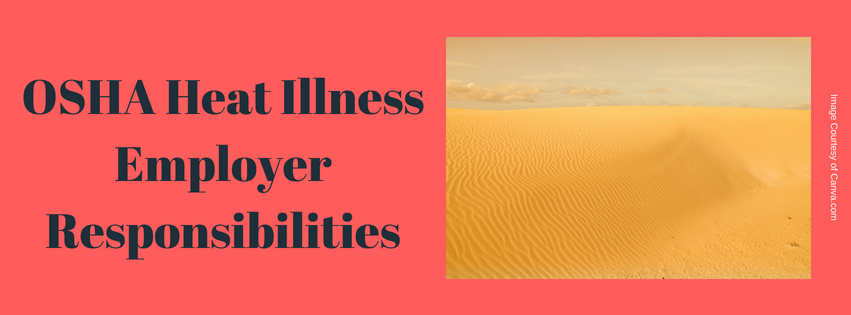Among many of the workplace hazards employers must protect their employees from under the Occupational Safety and Health Administration (OSHA), heat illness is a serious condition that can affect employees in seemingly safe work areas.
To help employers understand the risks associated with working in hot weather and how to prevent heat illness amongst their employees, OSHA uses the National Oceanographic and Atmospheric Administration’s (NOAA) heat index to measure an individual’s risk based off the combined temperature and humidity for that day – OSHA then providing accompanying regulations for each day’s risk level.
For an employer with workplaces outdoors or around hot machinery and factories, it’s imperative you know how to protect your employees from heat illness.
For Low Risk Levels (Less than 91°F)
As most employees can work safely under these temperatures, only basic heat prevention is enforced, including:
- Making sure water is available;
- Encouraging sunscreen use;
- Offering worker acclimatization; and
- Ensuring that medical services are nearby with an emergency plan in place if the heat increases.
If working in areas with direct sunlight or no breeze, follow Moderate Level precautions instead, while all workers wearing impermeable clothing should be monitored closely with additional precautions taken.
For Moderate Risk Levels (91°F – 103°F)
In addition to following Low Level precautions, employers should:
- Remind workers to drink about 4 cups/hour;
- Provide refresh training on heat illness prevention and treatment;
- Schedule frequent rests in cool, shaded areas; and
- Implement a buddy-system under a heat monitor’s supervision.
Any signs of heat illness should always be treated immediately – whether fighting minor headaches and fatigue by providing a break in the shade, or calling 911 for more serious symptoms.
For High Risk Levels (103°F – 115°F)
Under this risk level, any activity that can be rescheduled to a time with a lower heat index should be, while these precautions must be taken in addition to the steps above:
- Inform workers of the high heat levels;
- Strictly enforce water intake of about 4 cups/hour;
- Limit physical labor;
- Have a knowledgeable heat monitor on site and watching the workers at all times;
- Establish frequent rest schedules; and
- Use available cooling techniques.
Employers should also consider that working in direct sun or while wearing protective clothing can add up 15°F to the heat index.
For Very High/Extreme Risk Levels (More than 115°F)
All non-essential tasks must be rescheduled for a cooler day, while essential tasks should be moved to shaded areas, conducted at night, or at a time of day that would otherwise lessen the heat. If a task is essential, in addition to the heightened precautions above, the employer must:
- Tell the workers of the extreme heat;
- Enforce strict drinking and rest times;
- Use physiological monitoring techniques (checking one’s pulse, temperature, etc.); and
- Stop work immediately if these controls seem to be ineffective against heat illness.
Always Provide Workplace Awareness
Before starting each workday, all employers must check the heat index level – adjusting workloads accordingly – while also educating staff on the dangers and signs of heat illness, with the medical training to deal with potential emergencies.
Additionally, all workplaces and staff should be daily equipped with preventative supplies such as water and sunscreen, have real-time access to changes to the weather, and a knowledgeable person to regularly check on workers during higher risk levels.
To help keep up with these responsibilities, OSHA recommends daily employer checklists to ensure that you’re always prepared, while more information on heat illness prevention and requirements can be found here.
